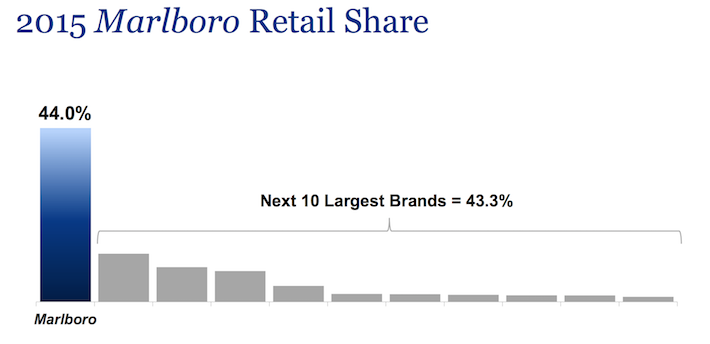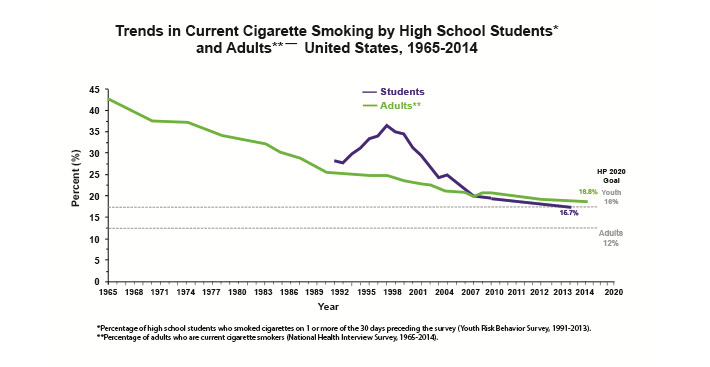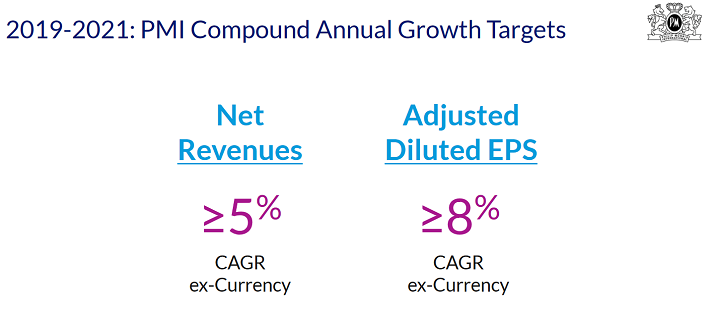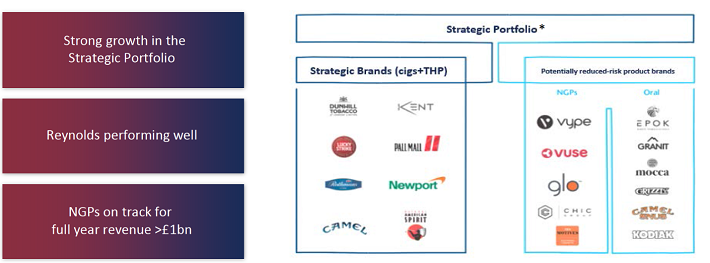As a business owner, selling products that have high profit margins along with strong brand awareness and an exceptionally loyal customer base is strongly desirable.
Q3 hedge fund letters, conference, scoops etc
ValueWalk readers can click here to instantly access an exclusive $100 discount on Sure Dividend’s premium online course Invest Like The Best, which contains a case-study-based investigation of how 6 of the world’s best investors beat the market over time.
The cigarette industry fits this bill, despite its declines. Tobacco stocks are particularly attractive to income-oriented investors thanks to their generous dividends and defensive characteristics during recession.
In this article, we will analyze the prospects of 5 of the largest tobacco stocks:
- Altria (MO
- Philip Morris (PM)
- British American Tobacco (BTI)
- Universal Corporation (UVV)
- Vector Group (VGR)
But first, an overview of declining tobacco usage.
Declining Smoking Rates
The percent of U.S. population that smokes is in a continuous decline.
Source: Centers for Disease Control
As shown in the above chart, the percent of the U.S. smoking adult population has steadily declined from about 42% in 1965 to 18.8% lately.
An increasing number of U.S. states have significantly raised the tax on cigarettes in order to reduce their budget deficits. For instance, California more than tripled the tax on a pack of cigarette, from $0.87 to $2.87 last year. Given the deteriorating budgets of most states and the appeal of tax increases on cigarettes, the situation will likely only get worse for tobacco producers.
These negative trends have kept many investors away from tobacco stocks. However, tobacco stocks can still generate solid total returns. The key behind an investment in tobacco stocks is the inelastic demand for cigarettes relative to their price due to the addictive nature of these products.
Tobacco companies have been able to raise their prices to help offset declining smoking rates. As a result, they have exceptional growth records. In addition, population growth partly offsets the effect of the declining percent of smokers.
Tobacco Stock #1: Altria (MO)
Altria is the market leader in American cigarette sales. Before 2003, the company was known as Philip Morris but was renamed as Altria after restructuring (including the spinoff of Philip Morris International in 2008).
The company owns many well-known brands, including Marlboro, Skoal and Copenhagen. The company’s operations are broken down as follows:
- Smokeable products (86% of revenue)
- Smokeless products (13% of revenue)
- Wine (1% of revenue)
Altria is the market leader in the US cigarette industry. In 2015, their flagship product Marlboro had more market share than the next 10 competitor products combined. Market shares for large cigarette brands are relatively stable due to advertising restrictions; Marlboro remains the #1 brand in cigarettes today.
Source: Altria Investor Relations
Altria has an exceptional growth record. It has grown its earnings-per-share in 9 out of the 10 last years. Over the last decade, it has grown its earnings-per-share at a 9.2% average annual rate. In addition, it has raised its dividend 52 times in the last 49 years. This is an impressive record, particularly given the aforementioned decline in the percent of the U.S. smoking population. This extraordinary performance is a testament to the strength of the business model of Altria and the reliability of its cash flows.
Altria has been able to offset smoking declines with meaningful price hikes. Even better, as its volume sales have decreased, its production cost has decreased as well. As a result, the company has steadily expanded its operating margin from 25.7% in 2010 to 37.8% this year.
Moreover, Altria enjoys extremely strong free cash flows. In fact, its capital expenses are almost negligible, as they have been less than 6% of its operating cash flows in every year in the last decade. As a result, almost all the operating cash flows end up as free cash flow. Thus, almost all earnings are available for shareholder distributions. This is the exact type of business model that Warren Buffett looks for; companies that need minimum capital expenses and thus enjoy strong free cash flows. Thanks to this strength, Altria pursues a dividend payout ratio around 80% and its management has confirmed that it will continue to distribute about 80% of the earnings in dividends.
The video below covers Altria’s dividend safety in detail:
Very few companies can grow their earnings-per-share at a 9.2% average annual rate while distributing almost all their earnings to their shareholders. This makes Altria an extremely rare stock.
The stock of Altria has lost 25% since it peaked in mid-2017. The stock has been adversely affected by the rising interest rate environment. As most of its shareholders hold the stock for its generous dividend, rising rates exert pressure on the stock, given that they enable investors to find decent yields elsewhere. The stock has also been hurt by uncertainty regarding the efforts of authorities to reduce nicotine levels in an attempt to make cigarettes less addictive. However, even if such a risk exists, it will take many years of negotiations and amendments until it materializes while its long-term effect on the smoking rate cannot be quantified. Finally, Altria is in negotiations with authorities to earn a “reduced-risk” label for its IQOS. As the outcome of the negotiations in uncertain, it has exerted additional pressure on the stock.
Thanks to all the above risk factors, Altria is now trading at a price-to-earnings ratio of 14.0, which is lower than its 10-year average of 16.2. Thus, the stock is cheaply valued right now. As we expect the stock to revert to its average valuation level over the next five years, the stock is likely to enjoy a 3.0% annualized boost thanks to the expansion of its price-to-earnings ratio.
Finally, thanks to its recent correction, Altria is currently offering a 5-year high dividend yield of 5.7%. Overall, the stock is likely to offer an average annual return of at least 15% over the next five years thanks to expected 7.0% annual earnings-per-share growth, its 5.7% dividend and a 3.0% annualized expansion of its price-to-earnings ratio. Thus, investors can initiate a position in this tobacco stalwart at a markedly attractive entry point.
Tobacco Stock #2: Philip Morris International (PM)
Philip Morris International was spun off from Altria in 2008 and is in charge of the production and distribution of Altria’s products outside of the United States. This includes the valuable Marlboro brand.
When Philip Morris was spun off from Altria, the former was considered the high-growth entity while the latter was considered the slow-growth company. In the first four years, the spin-off turned out according to expectations. Philip Morris grew its earnings-per-share by 56% whereas Altria grew its earnings-per-share by only 24% in that period.
However, the story has changed since then. Philip Morris has failed to grow its earnings in the last six years. The company has been hurt by a strong dollar, which has negatively affected the conversion of international sales into dollars.
Additionally, in the first years after the spin-off, the company performed extremely aggressive share repurchases even though it was distributing almost all its earnings as dividends. That was a double-edged sword. On the one hand, the share count decreased by 18% in that period and thus provided a significant boost to earnings-per-share and the stock price.
On the other hand, the company’s debt ballooned. The weak balance sheet forced the company to eliminate share repurchases in the last five years. The bottom line was also hurt by higher interest expense. Overall, Philip Morris has failed to grow its earnings in the last five years and thus its stock price has dramatically underperformed the market over this period, as it has remained essentially flat whereas the S&P has rallied 49%.
A potential game changer for the company is the expansion of IQOS in new markets. Philip Morris has increased its capital expenses in the last two years in order to develop and manufacture this new product. IQOS have met great success in some markets, such as Japan and Korea, and have helped the company grow its sales by 8% so far this year even though the volumes of traditional cigarettes have declined. They have also led management to provide rosy guidance for the next three years.
Source: Investor Presentation
Philip Morris currently offers an attractive 5.2% dividend yield. However, the stock is trading at a price-to-earnings ratio of 17.6, which is higher than our fair value estimate of 16.5. If the stock approaches our fair valuation level over the next five years, it will incur a 1.3% annualized drag due to contraction of its price-to-earnings ratio.
Looking for more Philip Morris dividend safety analysis? See the video below:
On the other hand, thanks to the promising prospects of IQOS, the stock is likely to offer high-single digit returns in the upcoming years, with its shareholders receiving a generous 5.2% dividend while waiting for the growth expectations to materialize.
Tobacco Stock #3: British American Tobacco (BTI)
British American Tobacco is one of the largest tobacco companies in the world, with a market capitalization of $79 billion. British American Tobacco owns the following tobacco brands, among others: Kool, Benson & Hedges, Dunhill, Kent, and Lucky Strike.
Source: Investor Presentation
In July of 2017, the company acquired the remaining 48% stake in Reynolds American Tobacco that it did not already own. Although the company is incorporated in the United Kingdom and headquartered in London, American investors can purchase its stock through American Depository Receipts that trade on the New York Stock Exchange under the ticker BTI. The United Kingdom does not impose a dividend withholding tax on United States investors.
British American Tobacco has grown its earnings-per-share at a 5.5% average annual rate over the last decade. However, most of this growth came in the first years. The performance in the last five years has been dismal, with only 2.7% annual earnings-per-share growth over this period.
Even worse, the company is currently facing an extremely strong headwind, as the FDA just confirmed that it will restrict the sales of flavored e-cigarettes to minors and pursue a national ban on menthol cigarettes and flavored cigars. In the first half of this year, British American Tobacco generated 39% of its revenues and 42% of its profits from the U.S. market. Therefore, it is easy to understand the impact of the recent announcement of the FDA on the company. Of course the new regulation will probably take years to come into effect but, whenever it does, it will have a severe impact on the results of British American Tobacco.
The stock has already incurred a dramatic plunge. In just 2 weeks since the FDA announcement, the stock has lost 20%. Even worse, the stock has plunged 50% in the last ten months and has thus fallen to an 8-year low level. As a result, the stock is now trading at a remarkably low price-to-earnings ratio of 8.2 while it is offering a 7.2% dividend yield. While the effect of the new policy of the FDA will certainly be negative for the company, it is hard to quantify the impact and identify the timing of the new policy. Moreover, given the low payout ratio of 59%, the dividend seems to be fairly safe even in the adverse scenario.
Overall, we feel that the market has overreacted in the case of British American Tobacco due to the great uncertainty that has resulted from the recent announcement of the FDA. In the short term, the stock is likely to remain under pressure. However, those who can ignore paper losses and maintain a long-term horizon are likely to enjoy double-digit returns from the current stock price thanks to the 7.2% dividend yield and the expansion of the price-to-earnings ratio from its current depressed level.
Tobacco Stock #4: Universal Corporation (UVV)
Universal Corporation is the world’s largest leaf tobacco exporter and importer. The company is the wholesale purchaser and processor of tobacco that operates between farms and the companies that manufacture cigarettes, pipe tobacco, and cigars. Universal Corporation was founded in 1886 and has a market capitalization of $1.7 billion. Universal Corporation has raised its dividend for 48 consecutive years and is therefore a Dividend Champion.
Source: Investor Presentation
Universal Corporation has exhibited a volatile performance record and has failed to grow its earnings over the last decade. While most investors tend to focus on the near-term growth prospects of a stock and ignore past performance, a consistent growth record is extremely important in investing decisions. As Universal Corporation is the leader in a declining industry, it is prudent to keep growth expectations at a minimum in order to avoid negative surprises in the future.
The stock is currently offering a 4.5% dividend yield, which is far above market’s average yield but is much lower than the yields of all the above tobacco stocks. In addition, the stock is now trading at a price-to-earnings ratio of 14.8, which is much higher than its 10-year average price-to-earnings ratio of 11.4. Consequently, the stock is likely to face a headwind from contraction of its valuation level in the upcoming years.
Overall, Universal Corporation has a much worse performance record than the other tobacco stocks mentioned in this article (with the possible exception of #5 below). It also has the worst dividend yield and the stock is trading above its average valuation level. As a result, investors who want to gain exposure to the tobacco industry should probably avoid the stock right now and turn their attention elsewhere.
Tobacco Stock #5: Vector Group
Vector Group is an unusual combination of a real estate investment firm and a tobacco company. The latter was founded in 1873 and continues to operate today as the Liggett Group while the real estate business came later. Vector has a market capitalization of $2 billion and is poised to produce $1.9 billion in total revenue this year.
Source: Investor Presentation
Like Universal Corporation, Vector Group has exhibited a volatile performance record and has failed to grow its earnings-per-share over the last decade. While its earnings have remained essentially flat in the last eight years, the company has increased its share count by 27% over this period. Therefore, it is prudent to keep growth expectations at a minimum for this company.
Moreover, Vector Group has a weak balance sheet. Its net debt of $1.3 B is about 16 times its annual earnings while its interest expense consumes about two-thirds of its operating income. As a result, the company is exposed to any unforeseen headwind. Its high leverage also helps explain its volatile performance record.
The only appealing feature of Vector Group is its extraordinary 11.5% dividend yield. Such a yield may be sufficient to entice many income-oriented investors. However, the latter should note that the dividend payout ratio currently stands at 320%, which is certainly unsustainable in the long run.
While the company has managed to maintain a payout ratio above 100% for the whole last decade, investors should not base their investing thesis on the ability of the company to maintain such irregular payout ratios for years. Overall, given the poor performance record of Vector Group and its weak balance sheet, we advise investors look elsewhere for high yields.
Final Thoughts on The Best Tobacco Stocks
From all the above tobacco stocks, only Universal Corporation has managed to match the performance of the S&P in the last two years. However, due to its poor growth record, its rich valuation and its inferior dividend yield, we advise investors to avoid the stock.
The other four tobacco stocks have dramatically underperformed the market in the last two years due to rising interest rates, which have pressured their valuation, and the regulatory challenges facing the tobacco industry. As a result, Altria and British American Tobacco have become attractively valued.
Thanks to its exceptional growth record, its solid business model and its low-risk profile, Altria seems to be the most attractive tobacco stock right now. It is likely to offer the highest average annual return with the lowest risk in the upcoming years.
British American Tobacco may offer high returns but it is much riskier than Altria due to the recent announcement of the FDA. Philip Morris is likely to offer high-single digit returns in the upcoming years thanks to the exciting prospects of IQOS in international markets so it is certainly attractive right now.
Overall, the cigarette industry benefits from favorable economic conditions. Economies of scale, streamlined manufacturing and distribution processes, and an inelastic demand curve (companies can raise prices without dramatically effecting consumer demand) all help cigarette companies generate strong cash flows.
Thanks for reading this article. Please send any feedback, corrections, or questions to support@suredividend.com.
Article by Aristofanis Papadatos, Sure Dividend
ValueWalk readers can click here to instantly access an exclusive $100 discount on Sure Dividend’s premium online course Invest Like The Best, which contains a case-study-based investigation of how 6 of the world’s best investors beat the market over time.






